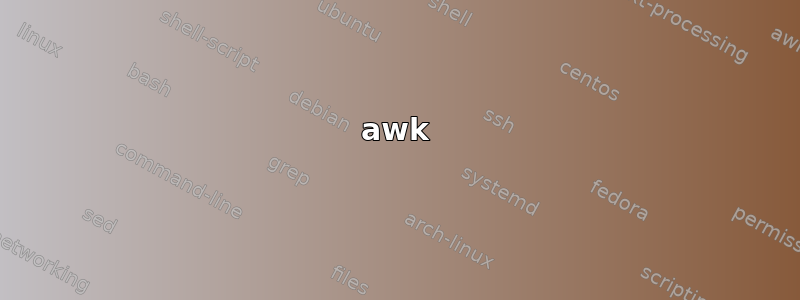
假设我有两行长度相同的数据
abcdb#lae#blabl#a
abc~bola~xblabl~a
我需要删除#第一行中的(第一行中可以有一个或多个#),以及下一行中同一位置的字符,使数据变成
abcdblaeblabla
abc~bla~blabla
我已经尝试过sed '/#/{n;s/~//g}',但它删除的字符比我想要的多。
答案1
awk
这些方法对每对行(1 和 2;3 和 4;等等)重复,处理与#每对第一行中的字符一样多的字符,并假设每对的两行长度相同。
与 GNU awk (Linux) 和 BSD awk (Mac) 兼容。
使用子字符串:
awk '{ a=$0 ; gsub(/#/,"",$0) ; print $0 ; getline ; for (n=1;n<=length(a);n++) if ( substr(a,n,1) != "#" ) printf "%s",substr($0,n,1) ; printf "%s",RS }' file.txt
相同的代码,针对更窄的屏幕重新格式化:
awk '{
a=$0 ;
gsub(/#/,"",$0) ;
print $0 ;
getline ;
for (n=1;n<=length(a);n++)
if ( substr(a,n,1) != "#" )
printf "%s",substr($0,n,1) ;
printf "%s",RS
}' file.txt
a=$0
保存第一行的副本。gsub(/#/,"",$0) ; print $0
删除#第一行中的所有内容(不是从副本中),然后打印修改后的第一行。getline
转到下一行。for (n=1;n<=length(a);n++)
逐步浏览第一行副本的每个字符。if ( substr(a,n,1) != "#" )
如果这个单字符子字符串不是#,...printf "%s",substr($0,n,1)
…然后打印第二行相应位置的字符。
printf "%s",RS
以换行符结束第二行。
使用数组:
awk '{ c=d="" ; elements=split($0,a,"") ; getline ; split($0,b,"") ; for (n=1;n<=elements;n++) if (a[n]!="#") { c = c a[n] ; d = d b[n] } ; print c ; print d }' file.txt
针对更窄的屏幕重新格式化:
awk '{
c=d="" ;
elements=split($0,a,"") ;
getline ;
split($0,b,"") ;
for (n=1;n<=elements;n++)
if (a[n]!="#")
{ c = c a[n] ; d = d b[n] } ;
print c ;
print d
}' file.txt
c=d=""
初始化两个空字符串。这些将成为两行输入的修改版本。如果输入的行数超过两行,则此步骤是必要的。elements=split($0,a,"")
将第一行输入转换为数组,每个数组元素一个字符。将数组元素的数量存储为变量elements。getline
转到下一行。split($0,b,"")
将第二行输入转换为数组,每个数组元素一个字符。for (n=1;n<=elements;n++)
逐步遍历第一行数组的每个元素。if (a[n]!="#")
如果这个单字符数组元素不是#,...{ c = c a[n] ; d = d b[n] }
...然后,对于两行中的每一行,保留位置 中的字符n。
print c ; print d
打印这两行的新版本。
警告:Mac (BSD) 版本的 awk 不会自动按数字顺序处理数组元素。这最初给了我令人惊讶的结果。
“for (indx in array)”循环遍历数组的顺序在 POSIX awk 中未定义,并且因实现而异。 gawk 允许您通过向 PROCINFO["sorted_in"] 分配特殊的预定义值来控制顺序。
元素1,2,3,...在创建时仍然用进行编号split,如 GNU awk 中一样,但 BSD awk 在使用 时不一定按该顺序看到它们for (n in array)。因此,你会得到乱码。
为了解决这个问题,您可以在创建数组时存储数组的长度(元素数量) - 例如elements=split($0,a,"")- 然后使用 迭代元素for (n=1;n<=elements;n++),就像我在这里所做的那样。
输入示例 ( file.txt):
abcdb#lae#blabl#a
abc~bola~xblabl~a
#alpha#beta#gamma#delta#epsilon#
abcdefghijklmnopqrstuvwxyzabcdef
输出示例:
abcdblaeblabla
abc~bla~blabla
alphabetagammadeltaepsilon
bcdefhijkmnopqstuvwyzabcde
答案2
您可以通过以下方式使用 sed 来完成此操作。将两条线都带入图案空间后,在两条线的开头放置两个标记。
然后开始将它们一次向右移动一个字符。在此移动过程中,请注意标记右侧的内容并采取相应的行动。
当标记到达图案空间的末尾时停止。现在,当标记的工作完成后,将其拿走,剩下的就是您想要的。注意标记是\n
sed -Ee '
/#/N;/\n/!b
s/\n/&&/;s/^/\n/
:a
/\n#(.*\n.*\n)./{
s//\n\1/;ba
}
s/\n(.)(.*\n.*)\n(.)/\1\n\2\3\n/
/\n$/!ba
s/\n//;s///2
' input
使用 Perl 可以按照以下思路解决:
perl -pe '
next unless /#/;
my($n,$p) = (scalar <>);
while ( /#/g ) {
pos($n) = pos() - 1 - $p++;
$n =~ s/\G.//;
}
y/#//d;s/\z/$n/;
' input_file
在职的:
1. Skip lines that donot have hash char.
2. Save the next line in $n and init. $p counter which keeps track of the number of hash chars erased till now.
3. Monitor the position of the hash char in a while loop and using info generate the position of the char to be deleted in next line.
4. Erase it using the \G metachar in s///
5. In the final step remove the hash chars from present line and append the next line to it.
显示了另一种方法,这次使用数组:
perl -aF'' -ne '
print,next unless /#/;
print,last if eof;
my @I = grep { $F[$_] ne "#" } 0 .. $#F;
my @N = split //, <>;
print @F[@I], @N[@I];
' input_file
在职的:
1. Invoke Perl to split each line on a per character basis and have it stored in the array @F anew for every line read.
2. Record the array indices for which the array element is a non hash character.
3. Readin the next line, split it on a per character basis and store in array @N.
4. Now its a matter of selecting the indices we stored in @I and fetch those from arrays @F and @N.
正则表达式的方法:
perl -pe '
$_ .= <> unless eof;
s/\G.(.*\n.{@{[+pos]}})./$1/ while /(?=#.*\n.)/g;
' input_file
描述 :
° 将下一行追加到当前行,只要它不是最后一行。
° 通过while循环记录第一行哈希字符的位置。
° 然后去掉原行中的hash字符以及下一行对应位置的字符。
° 退出 while 循环后,-p 选项将自动将 $_ 打印到标准输出。
纯字符串操作的方法:
perl -pe '
last if eof;
my $n = <>;
while ( (my $p = index($_,"#")) > -1 ) {
substr($_, $p, 1) = "" for $_, $n;
}
$_ .= $n;
' input_file
这涉及使用内置索引来检查哈希的位置,然后在内置的 substr 中使用它两次......在第一行和下一行上。
答案3
这在awk.当您看到 时#,请确定它在行中的位置。然后,对于该行和所有后续行,将该字符位置从该行中删除。
awk '
/#/ { pound=index($0, "#") }
{
if (pound)
print substr($0, 1, pound-1) substr($0, pound+1)
else
print
}
'
答案4
与 gnu awk 配合使用 gensub
awk '
/#/{
a=$0
b=length()
getline
$0=a RS$0
while($0!=a){
a=$0
$0=gensub("([^#]*)#(.{"b--"}).","\\1\\2",1)}
}1' infile
解释 :
/#/ :每行带有#
a=$0 :将行保存在 a 中
b=length() :获取 b 中的长度
getline : 获取下一行
$0=a RS$0 :将存储在 a 中的上一行添加到缓冲区 $0 的开头,后跟 RS 记录分隔符
现在 $0 包含 2 行
while($0!=a) : while a 中存储的行与缓冲区 $0 不同
a=$0 : 获取a中的缓冲区$0
$0=gensub("([^#]*)#(.{"b--"}).","\\1\\2",1) :删除 $0 中的第一个 # 以及 $0 中相应的字符第二行
同时将第一行的长度减 1 (b--),因为 1 # 被删除
1:当第一行不再有#时打印$0


